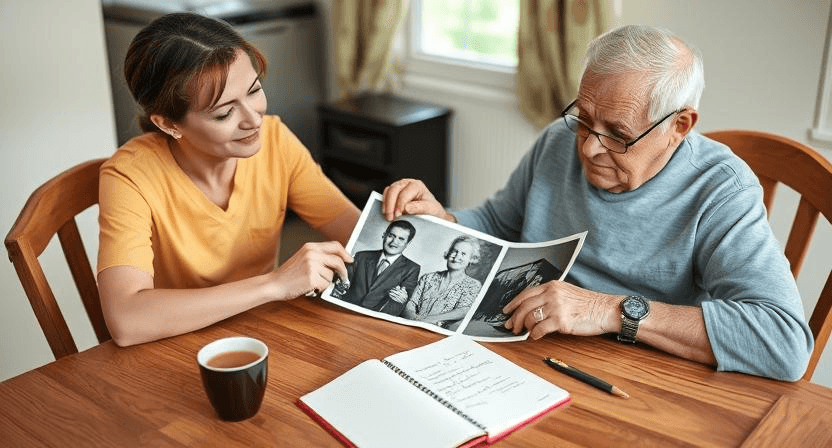Have you ever walked into a senior’s home for the first time—nervously exchanging smiles, struggling to find the right words? That initial awkwardness can feel like an insurmountable wall between you and the person you’re meant to care for. But what if I told you that with a few intentional practices, you could transform that wall into a bridge?
As someone who’s consulted with caregiving agencies across Canada for over a decade, I’ve witnessed firsthand how bedside manners can make or break the caregiving relationship. These interpersonal skills aren’t just niceties—they’re essential tools that enhance trust, improve care quality, and significantly boost seniors’ emotional well-being.
“The way we communicate with seniors can either open doors or build barriers,” shared Elaine, a veteran caregiver from Toronto. “Sometimes the medicine they need most is simply feeling heard and respected.”
In this guide, I’ll walk you through 10 actionable tips for mastering bedside manners, complete with real-world examples that show these principles in action. Whether you’re a professional caregiver or a family member stepping into this role, these strategies will help you create meaningful connections that benefit both you and the seniors in your care.
The Foundation of Bedside Manners
Bedside manners aren’t just for doctors in hospitals—they represent the blend of interpersonal skills that enable caregivers to connect authentically with seniors. This delicate mix of empathy, patience, active listening, and respect creates the foundation for truly effective care.
When done right, good bedside manners can transform the caregiving experience. They significantly reduce seniors’ anxiety and resistance to care, improve cooperation with treatment plans, and make the entire caregiving journey more rewarding for everyone involved.
“I used to think my job was primarily about completing tasks—medication, mobility assistance, hygiene,” admits Carlos, a caregiver of eight years. “But I quickly learned that how I perform those tasks matters just as much as completing them.”
The beauty of these skills is that they can be learned and refined. Let’s explore ten practical approaches you can implement starting today.
10 Tips for Mastering Bedside Manners
1. Practice Active Listening
Few things communicate respect more clearly than genuinely listening to someone. For seniors who may frequently feel overlooked or dismissed in our fast-paced society, being truly heard can be transformative.
Active listening involves maintaining comfortable eye contact, nodding to show engagement, and occasionally paraphrasing what you’ve heard to confirm understanding. Instead of formulating your response while they’re speaking, focus entirely on their words and the emotions behind them.
Maria, a caregiver in Toronto, noticed her client Mr. Chen becoming increasingly withdrawn during her visits. Rather than attributing it to his dementia progressing, she sat down one afternoon and simply asked, “How are you feeling today, Mr. Chen?” then waited without interrupting.
After a thoughtful pause, he shared that he deeply missed his weekly card games with friends—a tradition spanning decades that had ended when he became homebound. This revelation prompted Maria to arrange a virtual card game with Mr. Chen’s old friends, bringing back a spark she hadn’t seen in months.
“Sometimes the most important information comes after what seems like the end of the conversation,” Maria reflects. “If you rush to fill silence, you might miss what they really need to say.”
2. Use a Warm, Calm Tone
The human voice carries remarkable power—it can escalate tension or dissolve it, create distance or bridge it. For seniors, particularly those with sensory processing challenges or anxiety, a caregiver’s tone can set the emotional temperature of the entire interaction.
Practice speaking at a moderate pace, avoiding the common tendency to raise volume unnecessarily (which can come across as patronizing) unless they have hearing difficulties. Lower your pitch slightly, as higher pitches can be harder for some seniors to process comfortably.
James, a home health aide in Ottawa, consciously softened his naturally booming voice when assisting Mrs. Patel with her morning routine. Though initially just a professional technique, the approach paid unexpected dividends when Mrs. Patel confided in him weeks later.
“Your voice reminds me of my son’s when he explains things to his children,” she told him. “So patient, never making me feel rushed or burdensome.” This small adjustment helped transform their professional relationship into a genuinely warm human connection.
3. Show Patience During Challenges
We live in a society that values efficiency and speed—values that can sometimes work against effective senior care. Physical limitations, cognitive processing changes, or emotional needs might mean tasks take significantly longer than you initially anticipated.
Demonstrating patience—through your facial expressions, body language, and willingness to adjust timeframes—communicates something profound to your senior client: their dignity matters more than your schedule.
When Mrs. Lopez struggled to button her cardigan due to arthritis, her caregiver Aisha noticed frustration mounting in both of them. Rather than stepping in to complete the task (which would have been quicker), Aisha took a deep breath, sat down beside Mrs. Lopez, and softly said, “We have plenty of time. Would you like to continue or would you prefer help today?”
Mrs. Lopez chose to continue, and when she successfully fastened the final button minutes later, her beaming smile revealed something deeper than just accomplishment—it showed preserved dignity and autonomy.
4. Offer Genuine Empathy
Empathy—the ability to understand someone else’s feelings—forms the cornerstone of meaningful human connection. For seniors navigating losses, health challenges, and significant life transitions, encountering genuine empathy can be profoundly healing.
Demonstrate empathy by acknowledging emotions without judgment or attempts to “fix” them immediately. Simple phrases like “That sounds really difficult” or “I can see this is important to you” validate their experience without overstepping boundaries.
During a particularly difficult evening, Sam’s client Mr. Gordon became tearful while looking at family photos. Rather than changing the subject or offering platitudes, Sam sat quietly beside him and gently said, “I’d miss my family deeply too.” This small acknowledgment opened a meaningful conversation about Mr. Gordon’s feelings of isolation, ultimately strengthening their rapport significantly.
“Empathy isn’t about having answers,” Sam later reflected. “It’s about being willing to sit in uncomfortable emotions with someone else so they don’t have to face them alone.”
5. Learn Their Preferences
Each senior in your care has lived a rich, complex life filled with developed preferences, dislikes, and habits. Recognizing and honoring these individual traits acknowledges their personhood beyond their current care needs.
Take time to learn about their favorite foods, music preferences, daily routines, and comfort measures. Keep notes if needed, and incorporate these preferences into care whenever possible.
Lila discovered through casual conversation that her client Mrs. Kim had been a dedicated classical pianist in her younger years. Though Mrs. Kim could no longer play due to arthritis, Lila began playing classical music during their lunch preparation. This simple adjustment transformed their previously quiet mealtime routine into a shared pleasure, with Mrs. Kim often sharing stories about concerts she had performed or attended.
“I thought I was just providing background music,” Lila shared, “but I was actually unlocking decades of joyful memories.”

6. Respect Their Dignity
Loss of independence can threaten a person’s sense of dignity—something many seniors struggle with as they require increasing assistance. Preserving dignity through respectful care practices helps maintain their sense of self-worth and autonomy.
Always knock before entering their space, explain what you’re about to do before you do it, and ask for consent whenever possible. Provide privacy during personal care, and avoid infantilizing language (“sweetie,” “dearie”) unless they’ve indicated they appreciate such terms.
When assisting Mr. Singh with bathing, Priya always followed the same respectful protocol: knocking on the bathroom door (even though they were alone in the house), explaining each step before taking it, and positioning towels to maximize privacy. Though these measures added minutes to the task, Mr. Singh’s appreciation was evident when he described Priya to his family as “the most thoughtful caregiver” he’d ever had.
7. Use Positive Body Language
Communication research consistently shows that nonverbal cues carry significantly more weight than our words—especially important when working with seniors who may have hearing impairments or cognitive processing changes.
Position yourself at eye level rather than standing over them, maintain appropriate eye contact, lean in slightly to show engagement, and be mindful of facial expressions that might convey impatience. Even with masks (which became standard during pandemic protocols), your eyes and posture communicate volumes.
Emma, a newly hired home health aide, was nervous about establishing rapport with her client Mrs. Davis during the pandemic when masks obscured half their faces. She consciously focused on “smiling with her eyes” and using open, welcoming posture. After their third visit, Mrs. Davis remarked that despite never seeing Emma’s full face, she could “feel the smile” in her eyes—a connection that helped ease the isolation Mrs. Davis had been experiencing.
8. Celebrate Small Wins Together
Aging often brings a focus on losses and limitations rather than abilities and achievements. By intentionally celebrating even modest accomplishments, caregivers can shift this narrative toward one of capability and progress.
Recognize and verbally appreciate efforts, improvements, or milestones, no matter how small they might seem. The psychological boost from this positive reinforcement can significantly impact both mood and motivation.
After weeks of post-surgery rehabilitation, Mr. Ahmed took his first independent steps with his walker. His caregiver Noor’s authentic excitement and simple words—”You’re absolutely crushing it today!”—transformed what could have been just another therapy session into a memorable victory. Mr. Ahmed later told his daughter that Noor’s enthusiasm had given him the determination to work harder in subsequent therapy sessions.
9. Be Consistent and Reliable
For many seniors, particularly those experiencing cognitive changes, predictability provides an essential sense of security in a world that might feel increasingly unpredictable.
Establish and maintain consistent routines, arrive when expected, and clearly communicate any necessary changes well in advance. Reliability builds trust faster than perhaps any other quality.
When an unavoidable schedule change meant Carlos would arrive two hours later than usual the following day, he made sure to explain this to Mrs. Evans a full day in advance, write it on her calendar, and remind her before leaving. Though a simple courtesy, Mrs. Evans later expressed profound gratitude for being “kept in the loop” rather than left wondering—a small gesture that significantly reduced her anxiety about the schedule disruption.
10. Adapt to Their Communication Style
Each senior has unique communication preferences—some enjoy lengthy conversations while others prefer quiet companionship; some process information better visually while others need verbal explanations. Adapting to their style demonstrates both attentiveness and respect.
Observe how they communicate most comfortably and mirror that approach. Adjust for sensory needs, speaking louder if they have hearing impairments or providing written information for visual learners.
Noticing that Mrs. O’Connor spoke softly and seemed uncomfortable with boisterous conversation, her caregiver Tara consciously lowered her voice and adopted a gentler communication style. Within weeks, their quiet chats had developed a special intimacy that Mrs. O’Connor’s daughter noticed immediately. “Mom has always been reserved,” she told Tara. “The fact that you’ve matched her energy instead of trying to change it means the world to her.”
Putting It Into Practice
These ten approaches—active listening, warm tone, patience, empathy, personalization, dignity, positive body language, celebration, reliability, and adaptability—weave together to create what I call a caregiver’s “bedside magic.” When combined thoughtfully, they transform clinical care into human connection.
If implementing all ten tips feels overwhelming, start with just one. Perhaps choose the approach that seems most natural to your personality or most needed by the person in your care. Build from there, adding new techniques as earlier ones become second nature.
Remember that perfection isn’t the goal—authentic care is. Even seasoned caregivers have challenging days and interactions that don’t go as planned. The key is consistency and intention over time.
Sophie, a caregiver in Vancouver, shared a particularly encouraging story about this gradual approach. When she first began working with Mrs. Harrison, she encountered a withdrawn, distrustful client who barely acknowledged her presence. Rather than trying to force connection, Sophie focused primarily on being reliably punctual and practicing active listening whenever Mrs. Harrison did speak.
“It took nearly three months of small, consistent efforts,” Sophie recalls. “But the morning she greeted me with a hug instead of a nod was worth every patient moment.” Today, they share a warm rapport built on hundreds of small, intentional interactions.
Transforming Care Through Connection
Mastering bedside manners isn’t merely acquiring a professional skill—it’s about transforming caregiving from a series of tasks into a meaningful human relationship. These interpersonal approaches honor the senior’s lifetime of experiences while acknowledging their current needs.
As you implement these strategies, pay attention to which ones resonate most strongly with the senior in your care. Each person responds differently, and personalizing your approach demonstrates the very attentiveness these tips are designed to cultivate.
“The technical aspects of caregiving—medication management, mobility assistance, health monitoring—are certainly essential,” reflects Diane, a caregiving instructor in Ontario. “But I’ve never heard a family member say, ‘What we appreciated most was how efficiently she took vital signs.’ Instead, they treasure the caregiver who made their loved one laugh, who listened to the same stories with fresh interest, who treated them with unfailing dignity.”
Which tip will you try first? Perhaps start with the one that feels most natural or addresses the greatest current challenge in your caregiving relationship. Remember that each small effort builds toward a stronger connection—and every smile you earn is tangible proof that you’re making a difference that extends far beyond the physical care you provide.
After all, in the words of Maya Angelou, “People will forget what you said, people will forget what you did, but people will never forget how you made them feel.” And in caregiving, those feelings form the foundation of truly effective care.





